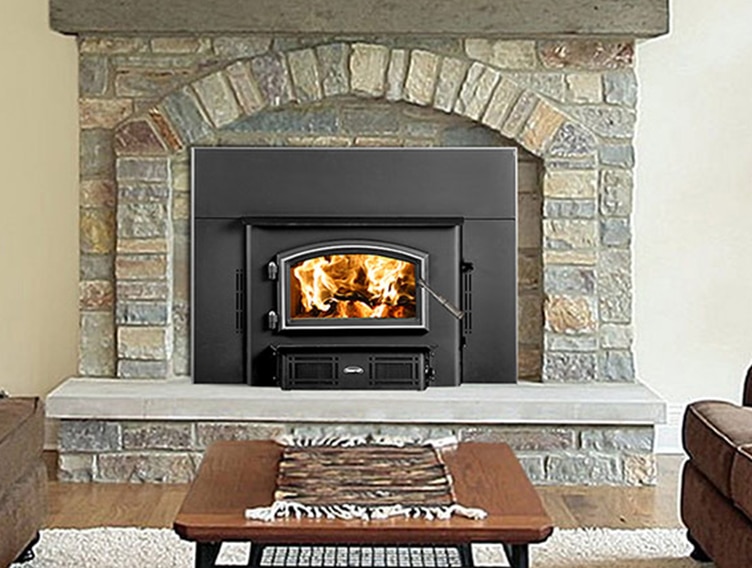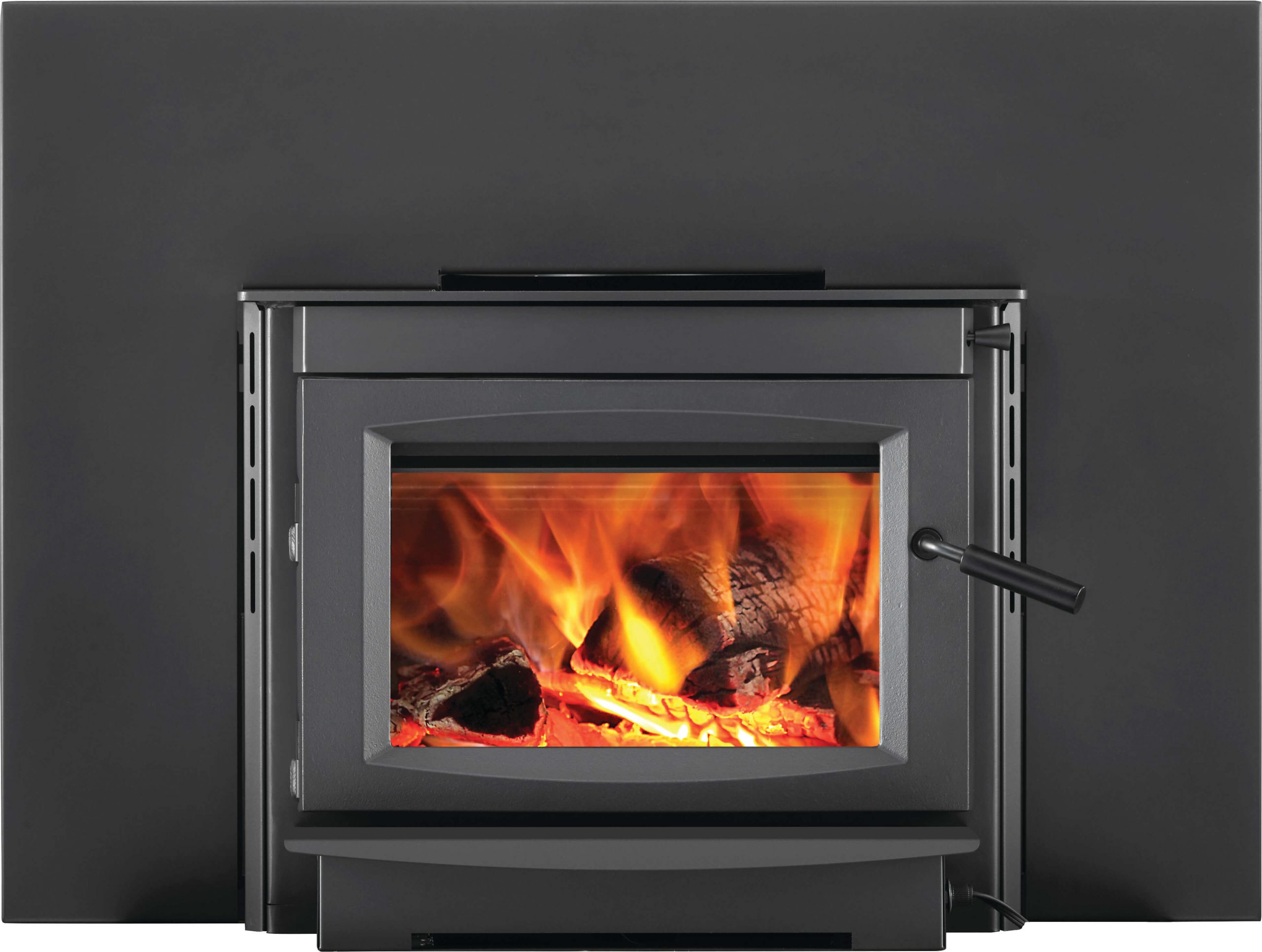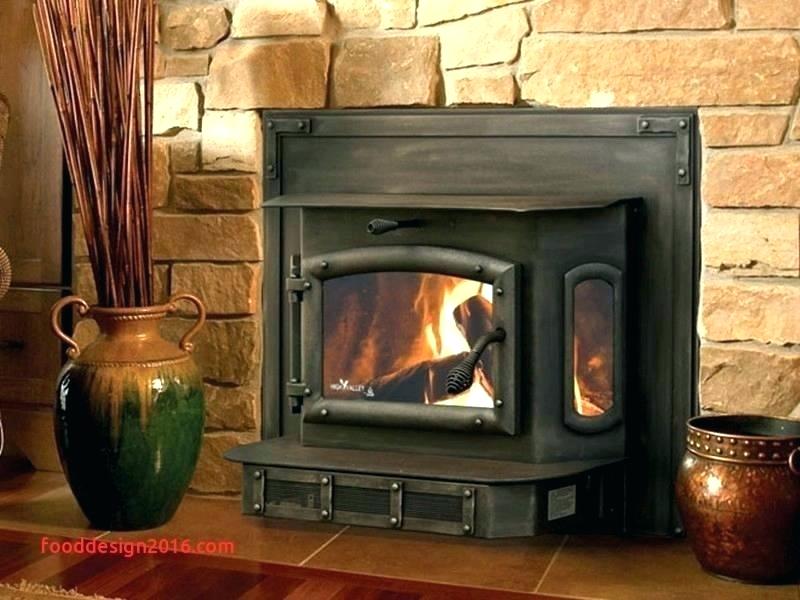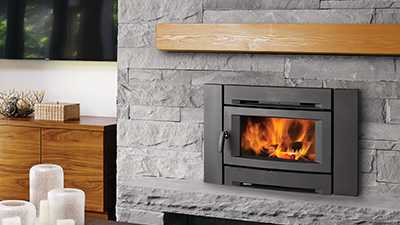A small wood fireplace insert can transform an old, inefficient fireplace into a high-efficiency heating source while maintaining the charm and ambiance of a traditional fire. These inserts are designed to fit into existing fireplaces, making them a practical and cost-effective solution for homeowners looking to upgrade their heating systems. In today’s article, we will cover the benefits, types, installation, maintenance, and common mistakes associated with small wood fireplace inserts.

Benefits of Small Wood Fireplace Inserts
Improved Heating Efficiency
One of the primary benefits of a small wood fireplace insert is its ability to significantly improve heating efficiency. Traditional open fireplaces are notoriously inefficient, often losing up to 90% of their heat up the chimney. In contrast, wood inserts are designed to burn wood more completely and distribute heat more effectively throughout the room. This increased efficiency can result in substantial savings on heating bills.
Environmental Advantages
Small wood fireplace inserts are also more environmentally friendly compared to traditional fireplaces. Modern inserts are engineered to burn wood more cleanly, reducing the amount of smoke and particulate emissions released into the atmosphere. Many models are certified by the Environmental Protection Agency (EPA), ensuring they meet stringent emissions standards. By choosing an EPA-certified insert, homeowners can reduce their carbon footprint and contribute to better air quality.
Enhanced Safety
Safety is another significant advantage of small wood fireplace inserts. Traditional fireplaces can pose several hazards, including the risk of sparks, embers, and creosote buildup, which can lead to chimney fires. Wood inserts are designed with safety features such as tightly sealed doors and advanced combustion technology, which minimizes the risk of accidental fires and reduces the accumulation of creosote in the chimney.

Aesthetic Appeal
A small wood fireplace insert can enhance the aesthetic appeal of a room by giving a dated fireplace a fresh, modern look. These inserts come in various styles and finishes, allowing homeowners to choose a design that complements their decor. Whether you prefer a classic cast iron look or a sleek, contemporary design, there is an insert to suit every taste and home style.
Versatility and Convenience
Wood fireplace inserts offer versatility and convenience, providing an efficient heat source that can also serve as a backup during power outages. Many models include features such as variable speed blowers to distribute heat evenly, easy-to-clean ash pans, and thermostatic controls for maintaining a consistent temperature. These features make wood inserts a practical and convenient heating solution.
Increased Home Value
Investing in a small wood fireplace insert can also increase the value of your home. Potential buyers often view efficient, attractive heating solutions as a desirable feature. By upgrading an old, inefficient fireplace with a modern wood insert, homeowners can enhance their property’s appeal and potentially increase its resale value.

Types of Small Wood Fireplace Inserts
Catalytic Wood Inserts
Catalytic wood inserts use a catalytic combustor to increase the efficiency of the wood-burning process. The combustor breaks down smoke particles and gases at lower temperatures, resulting in a more complete combustion and higher heat output. Catalytic inserts are known for their long burn times and reduced emissions, making them an excellent choice for environmentally conscious homeowners.
Non-Catalytic Wood Inserts
Non-catalytic wood inserts rely on a series of air tubes or baffles to introduce secondary combustion air, promoting a more complete burn. These inserts are typically easier to operate and require less maintenance than catalytic models. While they may not achieve the same level of efficiency as catalytic inserts, they still offer significant improvements over traditional open fireplaces.
Pellet Inserts
Pellet inserts are a type of wood-burning insert that uses compressed wood pellets as fuel. These inserts are highly efficient and produce very low emissions. Pellet inserts feature automatic feeding systems that supply pellets to the burn chamber, reducing the need for frequent refueling. They also offer convenient features such as programmable thermostats and remote controls, making them a user-friendly option.

Hybrid Wood Inserts
Hybrid wood inserts combine the benefits of both catalytic and non-catalytic technologies. They use a catalytic combustor for primary combustion and secondary air tubes or baffles for secondary combustion. This combination results in exceptionally high efficiency and low emissions. Hybrid inserts are ideal for homeowners looking for the best of both worlds in terms of performance and convenience.
High-Efficiency Wood Inserts
High-efficiency wood inserts are designed to maximize heat output while minimizing fuel consumption. These inserts feature advanced combustion technology, high-quality materials, and airtight construction to achieve optimal performance. They are often EPA-certified and meet stringent efficiency and emissions standards. High-efficiency inserts are an excellent choice for those seeking maximum heating power and environmental benefits.
Contemporary Wood Inserts
Contemporary wood inserts offer a modern take on traditional wood-burning stoves. They feature sleek, minimalist designs and large viewing windows, allowing for an unobstructed view of the fire. Contemporary inserts are available in various sizes and finishes, making them a stylish addition to any home. They combine aesthetic appeal with high efficiency, providing both form and function.

Interesting Articles You May Want to Check:
- Fireplace Insert Trim
- Outdoor Wood Burning Fireplace Insert
- Valor Fireplace Inserts
- Fireplace Insert Trim Ideas
- Electric Fireplace Insert Troubleshooting
Installation and Setup
Assessing Your Fireplace
Before installing a small wood fireplace insert, it’s essential to assess your existing fireplace to ensure it can accommodate the insert. Measure the dimensions of the fireplace opening, including width, height, and depth, and compare them to the specifications of the insert you plan to install. Check the condition of the chimney and flue, and address any necessary repairs or cleaning before proceeding with the installation.
Choosing the Right Insert
Selecting the right insert involves considering several factors, including the size of your fireplace, the heating needs of your home, and your aesthetic preferences. Ensure the insert you choose is appropriately sized for your fireplace and capable of heating the intended area. Consider the features and design elements that are important to you, such as blower systems, ash pans, and style options.
Preparing for Installation
Proper preparation is crucial for a successful installation. Start by thoroughly cleaning the fireplace and chimney to remove any debris, soot, or creosote buildup. Install a stainless steel chimney liner if required, as this will improve the efficiency and safety of the insert. Gather all necessary tools and materials, including a level, drill, and screws, to ensure you have everything you need before beginning the installation.

Installing the Insert
Follow the manufacturer’s instructions carefully to install the insert. Position the insert in the fireplace opening and use a level to ensure it is correctly aligned. Secure the insert in place using the provided brackets or screws. Connect the insert to the chimney liner, ensuring a tight and secure fit. Install any additional components, such as blowers or thermostats, as directed by the manufacturer.
Sealing and Insulating
Proper sealing and insulation are essential to maximize the efficiency of your wood insert. Use high-temperature silicone or stove cement to seal any gaps between the insert and the fireplace opening. Insulate around the insert with non-combustible materials to prevent heat loss and improve performance. This step helps ensure that the heat generated by the insert is efficiently distributed throughout the room.
Testing and Adjustments
Once the insert is installed, conduct a thorough test to ensure everything is functioning correctly. Light a small fire and observe the insert’s performance, checking for proper airflow, heat distribution, and any signs of smoke or leaks. Make any necessary adjustments to improve efficiency and safety. Regularly inspect and maintain the insert to keep it operating at peak performance.

Maintenance and Care
Regular Cleaning
Regular cleaning is essential to keep your small wood fireplace insert operating efficiently and safely. Remove ash and debris from the firebox after each use to prevent buildup. Clean the glass door with a non-abrasive cleaner to maintain clear visibility. Periodically check and clean the chimney liner to prevent creosote accumulation, which can pose a fire hazard.
Inspecting the Gaskets
The gaskets on the door and other components of the insert play a crucial role in maintaining an airtight seal. Inspect the gaskets regularly for signs of wear or damage, such as cracks or fraying. Replace any worn or damaged gaskets promptly to ensure the insert operates efficiently and safely. Properly functioning gaskets are essential for preventing air leaks and maximizing heat output.
Checking the Catalytic Combustor
If your insert features a catalytic combustor, it’s important to inspect and maintain it regularly. Check the combustor for signs of damage or blockage, and clean it according to the manufacturer’s instructions. Replace the combustor if it becomes damaged or ineffective. Proper maintenance of the catalytic combustor is essential for maintaining high efficiency and low emissions.

Maintaining the Blower System
If your insert includes a blower system, regular maintenance is necessary to keep it functioning properly. Clean the blower and air vents to remove dust and debris, which can impede airflow and reduce efficiency. Lubricate the blower motor as needed to ensure smooth operation. Regular maintenance of the blower system helps maintain optimal heat distribution and performance.
Annual Professional Inspections
In addition to regular maintenance, schedule an annual professional inspection of your wood insert and chimney. A professional can identify any potential issues, such as cracks, leaks, or creosote buildup, and provide necessary repairs or cleaning. Regular professional inspections ensure the safety and longevity of your insert and chimney system.
Monitoring for Signs of Wear
Regularly monitor your small wood fireplace insert for signs of wear or damage, such as cracks in the firebox, warped components, or deteriorating seals. Address any issues promptly to prevent further damage and ensure safe operation. Keeping a close eye on the condition of your insert helps maintain its efficiency and extend its lifespan.

Common Mistakes to Avoid
Improper Sizing
One common mistake is selecting a wood insert that is not appropriately sized for your fireplace or heating needs. An insert that is too large or too small can lead to inefficient operation and inadequate heating. Ensure you measure your fireplace accurately and choose an insert that matches your heating requirements and fits properly within the fireplace opening.
Neglecting Chimney Maintenance
Neglecting regular chimney maintenance can lead to dangerous creosote buildup and reduced efficiency. Regularly clean the chimney and have it inspected by a professional to ensure it is in good condition. Failing to maintain the chimney can result in poor airflow, increased emissions, and a higher risk of chimney fires.
Ignoring Manufacturer’s Instructions
Ignoring the manufacturer’s installation and maintenance instructions can result in improper operation and potential safety hazards. Always follow the manufacturer’s guidelines for installing, operating, and maintaining your wood insert. Adhering to these instructions ensures the insert operates safely and efficiently, providing optimal performance.
Using Improper Fuel
Using improper fuel, such as wet or treated wood, can reduce the efficiency of your wood insert and increase emissions. Always use seasoned, dry wood to ensure a clean, efficient burn. Avoid burning materials such as paper, cardboard, or treated wood, as these can produce harmful emissions and damage the insert.
Overloading the Insert
Overloading the firebox with too much wood can lead to inefficient combustion and excessive smoke production. Follow the manufacturer’s recommendations for the appropriate amount of wood to use. Properly loading the insert ensures optimal airflow and combustion, resulting in higher efficiency and lower emissions.
Failing to Maintain Gaskets and Seals
Neglecting to maintain the gaskets and seals on your wood insert can result in air leaks and reduced efficiency. Regularly inspect and replace any worn or damaged gaskets to ensure a tight, airtight seal. Properly functioning gaskets are essential for maintaining efficient operation and preventing air leaks.

Common FAQs
What are the benefits of using a small wood fireplace insert?
Small wood fireplace inserts offer numerous benefits, including improved heating efficiency, reduced emissions, and enhanced safety. They are designed to burn wood more completely, distributing heat more effectively throughout the room and reducing heating costs. Inserts also minimize the risk of sparks, embers, and creosote buildup, making them a safer option compared to traditional open fireplaces. Additionally, they come in various styles and finishes, enhancing the aesthetic appeal of your home.
How do I install a small wood fireplace insert?
Installing a small wood fireplace insert involves several steps. First, measure the dimensions of your existing fireplace to ensure a proper fit. Clean the fireplace and chimney thoroughly, and install a stainless steel chimney liner if required. Position the insert in the fireplace opening and secure it using the provided brackets or screws. Connect the insert to the chimney liner, ensuring a tight fit, and seal any gaps with high-temperature silicone or stove cement. Follow the manufacturer’s instructions carefully and conduct a thorough test to ensure proper operation.
How do I maintain and care for my small wood fireplace insert?
Regular maintenance is essential to keep your insert operating efficiently and safely. Clean the firebox after each use, remove ash and debris, and clean the glass door with a non-abrasive cleaner. Inspect the gaskets and replace them if necessary to maintain an airtight seal. If your insert has a catalytic combustor, clean and inspect it regularly. Maintain the blower system by cleaning the blower and air vents and lubricating the motor as needed. Schedule annual professional inspections to ensure the insert and chimney are in good condition.

What types of small wood fireplace inserts are available?
Several types of small wood fireplace inserts are available, including catalytic, non-catalytic, pellet, hybrid, high-efficiency, and contemporary models. Catalytic inserts use a catalytic combustor for higher efficiency and reduced emissions. Non-catalytic inserts rely on secondary air tubes or baffles for a complete burn. Pellet inserts use compressed wood pellets and feature automatic feeding systems. Hybrid inserts combine catalytic and non-catalytic technologies for optimal performance. High-efficiency inserts maximize heat output and minimize fuel consumption, while contemporary inserts offer sleek, modern designs.
What common mistakes should I avoid when using a small wood fireplace insert?
Common mistakes include improper sizing, neglecting chimney maintenance, ignoring the manufacturer’s instructions, using improper fuel, overloading the insert, and failing to maintain gaskets and seals. Ensure you select an appropriately sized insert for your fireplace and heating needs. Regularly clean and inspect the chimney to prevent creosote buildup. Follow the manufacturer’s guidelines for installation, operation, and maintenance. Use seasoned, dry wood and avoid burning materials that produce harmful emissions. Properly load the firebox and regularly inspect and replace gaskets to maintain efficient operation.
Can a small wood fireplace insert increase the value of my home?
Investing in a small wood fireplace insert can increase the value of your home by enhancing its heating efficiency, safety, and aesthetic appeal. Potential buyers often view efficient and attractive heating solutions as desirable features. Upgrading an old, inefficient fireplace with a modern wood insert can improve your home’s appeal and potentially increase its resale value. The energy savings and environmental benefits provided by a wood insert can also be attractive selling points for eco-conscious buyers.

Related Posts:
- Gas Fireplace Inserts Reviews Consumer Reports
- Small Wood Fireplace Insert
- Electric Fireplace Insert Without Heat
- Electric Fireplace Insert for Existing Fireplace
- Electric Fireplace Insert Stone
- Gas Fireplace Inserts for Heating
- Ceramic Fireplace Insert
- DIY Gas Fireplace Insert
- Gas Fireplace Insert Design Ideas
- Fireplace Insert for RV
